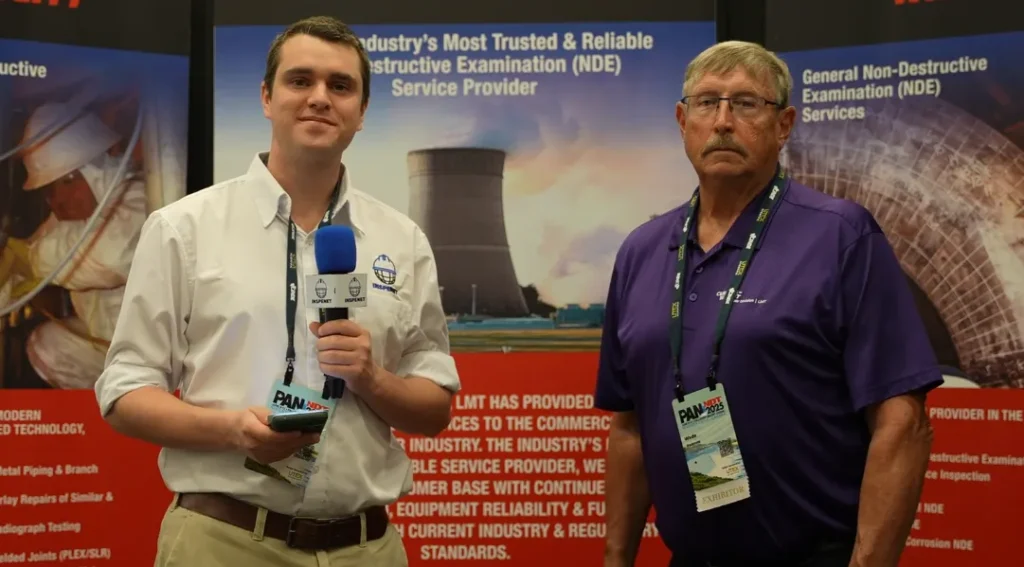Nuclear inspection and digital traceability with Curtiss-Wright
During the PANNDT event, Wade Padrnos, Technical Training Manager at Curtiss-Wright, shared details about the company's role in the nuclear industry. Although it is a conglomerate with multiple divisions, Wade specifically represents the area that provides nuclear inspection services using non-destructive testing (NDT) aimed at ensuring the structural integrity of components within nuclear plants.
From advanced ultrasound to cloud storage, the company has developed an operation where the traceability of every piece of inspection data is as important as the inspection itself, with a technical approach that is fully aligned with the strict regulatory requirements of the U.S. Nuclear Regulatory Commission (NRC).
Curtiss-Wright and its nuclear division
Curtiss-Wright is a global company with a presence in strategic sectors such as defense, energy and aerospace. In this case, the interview with Wade Padrnos focused on the nuclear division, which acts as a specialized provider of technical inspection services for nuclear power plants in the United States, Europe and South Africa.
Unlike other areas of the conglomerate that develop components or mechanical solutions, this unit operates as a critical support in quality control. Its field of action includes techniques such as:
- Conventional and phased array ultrasonic testing
- Magnetic particle method
- Liquid penetrant testing
- Visual tests
This technical range allows it to intervene at various points in the life cycle of nuclear components, ensuring that they meet the highest standards of safety and structural integrity.
Nuclear inspection with advanced technology
Although artificial intelligence has not yet been fully integrated into its processes, the company does employ state-of-the-art technological tools in its inspections. According to Wade, the use of techniques such as the Total Focusing Method (TFM) or phased array has significantly improved the quality of analysis and reduced the margins of human error.
In addition, Level 3 inspectors are responsible for interpreting the data collected, which ensures the validation of the technical instrument and that of specialized human judgment. This balance between partial automation and analytical expertise makes a difference in an environment where failure can mean irreversible consequences.

The heart of regulatory compliance
One of the most relevant aspects of the interview was the way in which the company manages the traceability of its inspections, since, being a highly regulated industry, all records must be kept available for immediate review in case of an audit or requirement by the NRC.
We are required by the NRC, the Nuclear Regulatory Commission in the States, to follow all of their documentation and so forth of all of our inspections as far as maintaining our data, maintaining our scans, and having them available for review at any point in time.
Wade Padrnos.
The use of cloud storage strengthens the transparency of the process and protects against accidental data loss, which is crucial when it comes to keeping records for years to come.
Automation in nuclear inspection: precision to the millimeter
Although Wade's division is not directly linked to the aerospace branch of the group, they do employ automated motion and control solutions in their inspection activities. This includes the use of scanners custom-designed to suit the components they need to analyze, as well as robotic systems that allow them to cover large areas without manual intervention.
This type of automation makes it possible to achieve:
- Increased measurement repeatability
- Reduction of inspection times
- Improved coverage and failure detection
These solutions are particularly useful for inspections in complex or difficult to access environments, where personnel safety is also a key factor.
The role of artificial intelligence
While many companies in the industry are exploring artificial intelligence and predictive analytics, Wade clarifies that Curtiss-Wright has not yet incorporated AI into its inspection processes. The decision is in response to the need to maintain a high level of human control over the data and the accuracy currently achieved by its certified inspectors.
However, this does not rule out its future implementation, as AI solutions become more robust, and it could be incorporated as a complementary tool for pattern analysis or to reduce the burden on repetitive processes.
Technical vision aligned with the challenges of the nuclear industry
What stands out about the conversation with Wade Padrnos is the clarity with which Curtiss-Wright has structured its nuclear inspection division, through the use of advanced technologies, rigorous regulatory compliance and digital traceability. While the focus is not yet on automating analysis through AI, their combination of modern techniques and human technical expertise represents an effective model in the energy industry.
In a context where nuclear inspection is key to operational continuity and risk prevention, companies like Curtiss-Wright not only guarantee quality, but also institutional trust and legal compliance.
For more content on PANNDT 2025, visit our YouTube channel and our LinkedIn profile.
Source: Inspenet.


